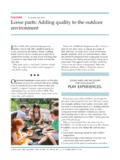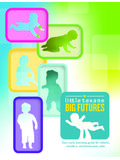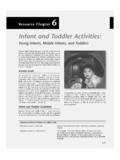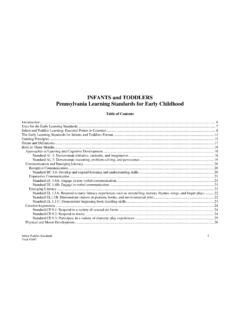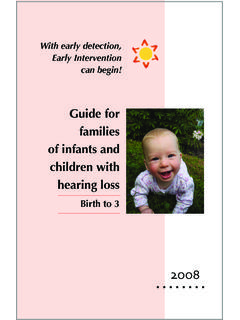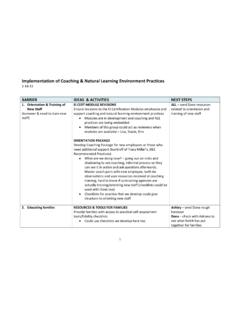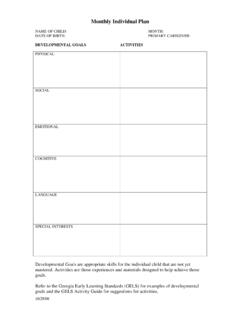Transcription of feature by Hannah Mills Developmentally …
1 Texas Child Care quarTerly / winTer 2013 / VOluMe 37, nO. 3 / you are standing in your infant classroom wondering whether you are really providing devel-opmentally appropriate activities for the babies. Or imagine interacting with a group of toddlers and questioning whether your interactions enhance or limit their sense of developing autonomy and inde-pendence. How do you decide what to plan and how to offer new experiences, ideas, and activities? n n nFor early childhood educators, planning and assessment rely on a firm understanding of the milestones and typical sequence of infant and tod-dler development. Similarly, early care and educa-tion professionals rely on their knowledge of how children s individual differences in both biology (nature) and experiences (nurture) impact each developmental task and its timing. According to Piaget (1978), children s cognitive development may differ greatly between infancy and toddlerhood.
2 As early childhood educators, we know that foundational knowledge knowing what to expect, and when is essential for a child s opti-mum growth. Current research points to the importance of creat-ing a care and education environment that reflects Developmentally appropriate practices (Copple and Bredekamp 2009). This standard suggests that activi-ties, interactions, materials, and equipment reflect both the developmental skills of the group and the skills, needs, and interests of every child in the group. Typically, Developmentally appropriate practices (DAP) are the result of observations and assessments that guide teachers knowledge of children over time. Integrating DAP with ongoing assessment offers teachers evidence of children s increasing skills in all developmental domains. The process also alerts teachers to weaknesses and lags that might require additional support or inter-vention.
3 Frequently, early childhood educators inte-grate the practice of scaffolding providing support that enables children to reach the next skill level. Vygotsky (1978) suggested that scaffolding might be provided by either an interested adult or another child who engenders excitement, curiosity, and skill refinement. Similarly, Vygotsky s concept of the zone of proxi-mal development relies on social interactions that keep babies engaged. Activities that are outside a child s zone are either boring (things the child already knows) or frustrating (things that are too demanding or rigorous for the child s developmental level). For example, 9-month-old Jake is engaged in locomotion driven by his curiosity. Keeping Jake in a crib with a mobile to kick does nothing to further his knowledge of his environment and the people and things in it.
4 Similarly, Jake isn t ready to pedal a tri- feature by Hannah MillsDevelopmentally appropriate practices in infant and toddler classroomsphOTO by susan gaeTz Texas Child Care quarTerly / winTer 2013 / VOluMe 37, nO. 3 / He has to master other tasks before he has the balance, agility, strength, and coordination to move in this independent for infantsInfants have complex and rapidly changing needs and frequently seek both support and security from early care and education professionals (Bredekamp and Copple 2009). For instance, when babies extend their arms, they signal that they want to be held. There is no verbal communication, and responsive caregivers understand and interpret the signal and the need. Similarly, a baby may track a caregiver s move-ments and whimper for attention in an effort to tighten an attachment relationship the bond that babies form with caring, attentive, and supportive adults (Ainsworth and Bowlby 1991).
5 Consider and evaluate your early care and educa-tion style against these recommendations for devel-opmentally appropriate practices for infants (Bredekamp and Copple 2009). respond to infants needs. While this often means holding, cooing, and comforting, it sometimes means acknowledging without holding, directing infants to new activities, or responding to the infants needs with words, songs, rhymes, and toys instead of your arms or lap. Keep infants safe. Rapid skill development demands that caregivers anticipate and plan for leaps in a baby s developmental skills. In practice, this means things like having sturdy sides on cribs to pre-vent falls, removing cords and small objects that could cause strangulation or choking, and collecting and sanitizing toys that babies have mouthed. understand infants rhythms. Accommodate sleep-and-wake cycles, hunger, elimination, and calls for engagement.
6 Experienced caregivers understand, for example, that sleep-and-wake cycles vary by individual infant but in general 3-month-olds will alternate sleep and wake periods about every two hours or so during the day. talk with babies. Engage infants in the rhythms of communication and conversation. Identify objects; use proper names and titles (rather than non-specific diminutives like honey, sweetpea, or angel); describe textures, colors, noises, and odors. When speaking, do so clearly and slowly. Because infants are acquir-ing both receptive and expressive language, it s important for them to both hear words and begin associating those words with objects. anticipate development. Develop a strong knowledge base about infant developmental mile-stones in order to plan activities, materials, and schedules. A caregiver will know, for example, to offer a rattle to a 4-month-old to grab and shake, provide clear space for a 7-month-old to crawl, and help a 10- or 12-month-old to pull up and try stand-ing with the support of sturdy furnishings.
7 Plan. Work to develop a rhythm and routine for observations and record-keeping. Have a system for sharing information with families. Include reflection time in your schedule so that you can evaluate and accommodate each infant s zone of proximal devel-opment. Greet new interests with subtle environmen-tal (material, toy, equipment, and d cor) for toddlersDevelopmental tasks for toddlers are complex and interwoven, making huge demands on early care and education classrooms and teachers. Much of a child s first two years is spent in the creation of the child s first sense of self his or her early identity. This emerging identity colors all developmental domains how the child uses language, explores materials, moves independently, seeks support or comfort, establishes autonomy, and interacts with the people and things in the environment.
8 Physically, a toddler works to coordinate large and small muscles and needs experiences to address both. A toddler s physical skills, coupled with enormous cognitive gains, allow the move from involuntary, reflexive behaviors to deliberate, voluntary activity. Locomotion from creeping and crawling to walk-ing satisfies and propels curiosity and discovery. Sensory input, provided by materials, including toys, in the environment, helps toddlers learn how the world works both in possibility and limitation. fOundaTiOnal knOwledge is essenTial fOr a Child s OpTiMuM grOwTh. Texas Child Care quarTerly / winTer 2013 / VOluMe 37, nO. 3 / body size coupled with increased coordina-tion, balance, and stamina suggest important changes in a toddler s environment for play, sleep, eating, elimination, and other daily routines and patterns. Constant stimulation is critical for language devel-opment.
9 In conversations with toddlers, always attempt to convey meaning clearly (with short, direct sentences), and include appropriately chal-lenging words to support the explosion of a tod-dler s vocabulary. In addition, teachers can build on the toddler s typical telegraphic speech, adding words and infor-mation in grammatically correct form. For example, when Kasey says, key, go, a teacher responds, Yes, these are the keys that make the car run. Sharing books, stories, songs, finger plays, and signage helps toddlers build background knowledge. Playing with language and vocabulary paves the way for future literacy success. At the same time, it s important to recognize and support toddlers emotional and social development. Experienced teachers anticipate issues with self-reg-ulation (like sharing and biting), autonomy (like unwillingness to comply with requests), and intensi-ty (tantrums).
10 Build on the rapid changes in toddler develop-ment with these recommendations based on devel-opmentally appropriate practices (Bredekamp and Copple 2009). Offer choices. Encourage independence and autonomy by allowing a toddler to choose between two acceptable options (peas or green beans, for example). Initiate conversations. Both meaningful, fact-based conversations and silly, nonsense ones build vocabularies and communication skills. use positive guidance. Supervise carefully, anticipate likely behaviors, use physical touch to intervene, offer positive reinforcement and feedback, redirect toddler s attention to acceptable activities, and to assist without dominating. Let the environ-ment be a classroom assistant. Provide enough duplicate equipment to avoid sharing squabbles, make sure materials target developing skills safely, and provide props that encourage toddlers to explore primary emotions.






